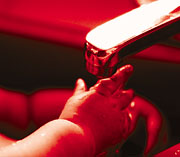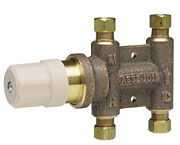
It was over 25 years ago when the U.S. Consumer Products Safety Commission reported, "...children under five years old account for almost 30% of the 100,000 annual bathtub- and shower-related accidents and burns from scalding, resulting in over 70 deaths each year." The report's recommendation was, "Turn down the temperature on the control water heater to 120 degrees F." Another report was issued in 1979 by the U.S.C.P.S.C. that stated, "An estimated 2,600 scald injuries per year are caused by excessive hot water..." and "...water scald injuries are severe and sometimes fatal." With the warning issued twenty-five years ago, you would think that we should be in good shape with reduced incidents of hot tap water scaldings. The most recent report from the National Safe Kids Campaign stated that 23,620 cases of water scalds were treated in hospitals, with one-fourth of the burns from hot tap water, and previous reports from the NSKC stated the average bathtub scald burn covers 12% of the body with a full thickness third-degree burn. And, some 4,000-5,000 tap water scalds per year are still occurring!
The plumbing community can be proud of the great advancements it has made over the past 25 years in consumer safety and protection, through new products, product standards, plumbing codes and enforcement. However, the facts are clear that the plumbing industry has yet to see its proudest moments relating to tap water scald protection.
Why Not 120 degrees F Water?
The problem today is the same as was reported over 25 years ago--hot water in excess of 120 degrees F. You might ask why we haven't followed this 25-year-old recommendation and adjusted the hot water source to 120 degrees F. There are two reasons why this hasn't happened, and why it probably will not.The first reason is that no one wants to run out of hot water in the shower. Homeowners expect their hot water will be available whenever and for as long as they need it. Running out of hot water is simply unacceptable in most homes. The problem stems from the fact that most common sources of residential hot water heaters are the 40- to 60-gallon type. With this amount of stored hot water, coupled with the normal peak hot water usage, most water heaters are set between 140 degrees F and 160 degrees F.
The second reason that has come to light in the past few years is Legionnaires' Disease. A 1996 report titled, "Risk Factors for Domestic Acquisition of Legionnaires Disease," concluded from case studies in 15 hospitals that "a portion of sporadic cases of Legionnaires' Disease may be residentially acquired and are associated with domestic potable water." This study agreed with previous reports that found 6% of the homes studied had Legionella pneumophilla. The Legionella exist in the biofilm on the inside of pipes. A report issued in June of 2000 by the State of Maryland supports this position and investigated the presence of Legionella in the hot water distribution systems in hospitals and institutions. The report hypothesized that the source of Legionella was the public/municipal water system. Legionella grows rapidly between 77 degrees F and 108 degrees F. The solution for preventing the Legionella is heating the water to 140 degrees F.
Water temperature of 140 degrees F kills Legionella almost immediately. Therefore, due to our water use patterns and concerns about Legionella, we are left with stored hot water in the scald temperature range.

Current Controls in the Codes
There are some controls of excessively hot water in current plumbing codes. Most plumbing codes require that when hot water comes from a combination heating system or tankless heater, the outlet hot water temperature shall be controlled with a tempering valve to 140 degrees F. The most common reference is to a tempering valve complying with ASSE (American Society of Sanitary Engineers) Standard 1017, titled, "Temperature Actuated Mixing Valves for Hot Water Distribution Systems." The only additional temperature protection required by most plumbing codes is for shower valves. For example, the International Plumbing Code, a model plumbing code, states as follows: "Section 424.4 Shower Valves. Shower and tub/shower combination valves shall be balanced pressure, thermostatic, or a combination of balanced pressure/thermostatic valves that conform to the requirements of ASSE 1016 or CSA B125. Valves shall be equipped with a means to limit the maximum setting of the valve to 120 degrees F, which shall be field adjustable in accordance with the manufacturers' instructions." The disturbing fact is that with these measures in place, there is no indication that the number of children being scalded by tap water has been decreasing over the past years.There are several reasons the current measures have not worked. The 140 degrees F temperature allowed by codes and recommended to combat Legionnaires' Disease is a scalding temperature, and at 140 degrees F, a child receives third-degree burns in 1.5 seconds. Additionally, when a residential water heater is used, the codes do not limit the temperature to 140 degrees F, so it is not uncommon to find water at 160 degrees F. In residential water heaters, 160 degrees F temperatures will scald a child with third-degree burns in only .25 seconds.
Another reason for the limited success of the current temperature restrictions is that the majority of children are scalded in tubs and sinks, and there are no temperature-limiting requirements on these products in the model plumbing codes. The current requirement for showers was originally to address slips and falls due to the rapid temperature changes in the water causing people to move quickly to escape the flow of water.

Pressure Balancing Valves
Still another reason for why the current temperature control measures aren't working better is that a reference to ASSE 1016 alone does not guarantee the protection from excessive hot water. In ASSE 1016, there are provisions for two different types of products. The problem is that the model codes treat the two types of products as similar, yet they are not the same. The first is Type P, and the second type is referred to as Type T or T/P. The ASSE 1016 Type P is a pressure balanced valve. Of the two types, the Type P is the most often installed. It responds only to pressure changes, and there are no performance requirements for cold water temperature. Type P valves also have only a mechanical limit stop to limit the rotation of the handle to the full hot position. And, the Type P valves must be set by the plumber after installation, as required by code, to 120 degrees F.In 1984, the U.S. Consumer Product Safety Commission released the following statement: "[There is] the potential scalding hazard associated with pressure balancing shower systems when not properly installed and adjusted. The commission is presently aware of 12 incidents, including four deaths...." "The commission...warns that scalding may occur in the shower systems when there is a failure on the part of the installer to set the temperature limiting device in the pressure balancing valve known as the limit stop." Even with a conscientious installer, the 120 degrees F can only be guaranteed at the moment the adjustment is made. As soon as the incoming water temperature changes, the outlet temperature will change. Remember, the Type P responds only to pressure changes; it cannot sense temperature changes, and the incoming water temperature does change, which will cause the outlet temperature to change.
In parts of the U.S. where the winters approach freezing, and the water source is from lakes and rivers, water temperature will drop into the 30s in winter and will rise into the 80s in the summer. Let's assume a more modest cold water seasonal temperature swing of 20 degrees F and that the ASSE 1016 Type P was set in the winter for 45 degrees F cold water for an outlet temperature of 120 degrees F maximum. In the summer, with a 20 degrees F rise in the cold water, it will allow the outlet temperature to rise to 130 degrees F. The scalding time for a child drops from three minutes at 120 degrees F to 10 seconds at 130 degrees F. Unfortunately, this is not the only temperature change you can expect; the hot water temperature will vary as well. The standard ANSI Z21.10.1 for Gas Water Heaters, Section 2.1.4 allows a tolerance of +/-10 degrees F for the thermostatic dial. That tolerance additionally allows for +/-10 degrees F tolerance in the high limit temperature of the hot water. In section 2.15.1, it states, "When water heaters are intended to deliver water at a temperature not to exceed 160 degrees F, the outlet water temperature shall not rise more than 30 degrees F above the initial water temperature, and in no case shall the outlet water temperature exceed 190 degrees F."
This test is with repeated draws of water, not unlike what might happen in a residential application. After repeated cycling, the water temperature leaving the water heater can rise 30 degrees F from the initial setting. Electric water heaters, per UL 174A, do not have a limit on temperature rise, but supply a maximum of 185 degrees F at the maximum thermostat settings. But you can expect a 15- to 20-degree temperature swing from the heating element from the on to off cycle. If the plumber sets the ASSE Type P accurately at 120 degrees F, but the hot water is not at its maximum expected temperature, the set high limit temperature of 120 degrees F can dangerously increase.
This 20 degrees F rise in the hot water inlet temperature can result in a 15 degrees F increase in the outlet temperature. The original 120 degrees F temperature setting is now set at 135 degrees F, and the scald time has decreased from three minutes to just .5 seconds! If a change occurs in both the hot and cold water incoming temperatures, with the cold increasing 20 degrees F and the hot increasing 20 degrees F, the result could be the rise of the original setting of 120 degrees F outlet tap water temperature to 150 degrees F. The time for a third-degree burn changes from three minutes at 120 degrees F to a mere .5 seconds at 150 degrees F!
Looking for Answers
The answer to scald protection lies in ASSE 1016 Types T and T/P. These devices limit the outlet temperature, not only with pressure changes, but with hot and cold inlet water temperature changes. Types T and T/P are thermostatic valves. This means they thermostatically sense the outlet temperature and adjust the amount of either hot or cold incoming water to maintain the initial set outlet temperatures. Thermostatic valves can be factory set or temperature limited, or set at the time of installation. Once the outlet temperature has been set, a valve complying with ASSE 1016 will maintain the outlet temperature of +/-3 degrees F from its set point with up to a 20% change in incoming water pressure and a 25 degrees F change in incoming water temperature.In addition to developing ASSE Standard 1016, ASSE also lists products that comply with the 1016 Standard. Currently, ASSE has nineteen manufacturers with a total of thirty models listed that are thermostatic and comply with the 1016 standard.
To reduce hot tap water scalding, there are several steps we can take to accomplish what we have failed to do for the past 25 years. First, we need to look at source hot water temperatures and where they exceed 140 degrees F, then control them back down to 140 degrees F using ASSE 1017 devices; there is no reason to exceed 140 degrees F in the hot water distribution system. At the fixtures, limit the hot water to 120 degrees F maximum. The common threshold of pain for most people is at 110 degrees F, but even at 120 degrees F, the time factor for injury allows for a margin of safety. To help insure the 120 degrees F maximum, we need to specify and install devices complying with ASSE 1016 Type T or T/P.
And finally, the model codes can help by requiring thermostatic protection for all tubs and combination tub/showers, as well as kitchen and bathroom sinks. Please remember that 5,000 children are treated each year in hospitals with third-degree burns, and a large percentage are scalded in tubs or sinks or the tub of a combination tub/shower. Your support of plumbing code changes will make the difference and help to eliminate scalding accidents!
For additional information, visit the Web sites at the bottom of this page.
